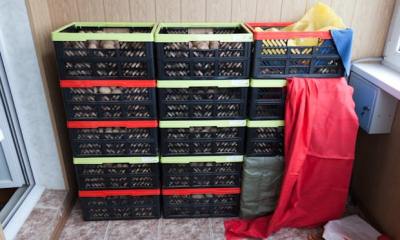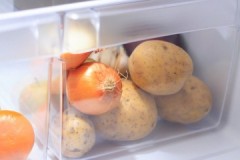Types of boxes for storing potatoes on the balcony in winter, instructions for making them yourself
 Potatoes are one of the most popular foods in the world. It tastes great in different forms - as chips or hash browns, boiled or baked.
Potatoes are one of the most popular foods in the world. It tastes great in different forms - as chips or hash browns, boiled or baked.
For year-round use, the vegetable requires long-term storage. Preserving potatoes in winter is not easy; you need to take into account that they do not freeze from the cold and do not begin to rot in the spring, when the temperature is constantly rising.
It is even more difficult to provide winter storage of vegetables for city residents. You will need a loggia or balcony, as well as a wooden insulated box for storing potatoes and other vegetables or a special container designed for these purposes.
We’ll talk about boxes for storing potatoes on the balcony in the article.
Content
Types of containers for potatoes
In a city apartment, vegetables are stored on the balcony or loggia. You can make your own vegetable storage in the form of a wooden box, insulated with foam plastic. And in cold weather, additionally cover the box with a thick blanket.
All homemade wooden containers should be painted to protect them from outside moisture. You can use plastic boxes or an old refrigerator after upgrading it. You can also buy a special container for storing vegetables on the balcony.
Plastic without heating
 Ventilated plastic containers or wooden boxes are suitable for storage.
Ventilated plastic containers or wooden boxes are suitable for storage.
Stack the drawers on top of each other for compactness.. They are breathable, so you don't have to worry about condensation. To protect against frost, cover the top of the potato boxes with a warm blanket.
On the balcony, the box can be placed on cardboard, wood or other material. Direct contact with concrete, metal or porcelain stoneware is not allowed.
This is the simplest and most inexpensive solution. However, this is the least effective option if your region experiences severe frosts. Since the blanket itself does little to protect potatoes from frost.
Thermobox made of plastic
This is a variant of a commercial device for preserving crops in winter. It's expensive, but its price is justified, since it eliminates unnecessary hassle and the risk of being left without supplies for the winter.
Thermoboxes can be of any size; moreover, you can order a product to fit the dimensions of your loggia. Such balcony cellars operate from the network, so you need to think in advance about the electrical wiring of the balcony.
The risk of food spoilage is significantly reduced. The temperature in the container is usually between +2 and +7°C, which prevents the fruit from rotting.
Heated soft container
 If the balcony is small, there is not enough space for large structures, You can consider thermal containers for storing vegetables that do not take up much space and are beautiful to look at.
If the balcony is small, there is not enough space for large structures, You can consider thermal containers for storing vegetables that do not take up much space and are beautiful to look at.
Note the soft container for storing seasonal vegetables, reminiscent of a large backpack.
It is made of a synthetic waterproof three-layer material with a synthetic padding between them.This material does not allow cold to penetrate inside and does not release heat outside.
The container is equipped with a thermostat and a wire heater. The required temperature is maintained automatically, but can be set manually. You can reduce the humidity in the box by sprinkling the potatoes with onion skins and chalk.
To prevent the potatoes from sprouting, a layer of straw is placed in the box as a layer. Convenience of loading vegetables is provided by two valves - lower and upper. The fabric container is light in weight (3.5 kg) and small in size.
In the summer, you can put it in a bag-cover and put it in a closet or bedside table. The volume of such a balcony cellar is from 95 to 300 liters.
How to make a chest with your own hands?
A homemade cellar most often resembles just a wooden box. It is well insulated inside and thanks to this it maintains a positive temperature. When the temperature drops below zero, the electric heating turns on if the master took care of this in advance. The size of the home cellar depends on your desires, capabilities and the size of the balcony.
It is best to store potatoes in a box that maintains a temperature of 2-3 degrees Celsius and a humidity of 40-60%. The potato box should have holes through which air can flow freely into both the bottom and top layers. It’s good if the walls, lid and bottom are completely perforated. To avoid obstructing air access to the container, potatoes should be stored on their legs.
Box for storing potatoes on the balcony in winter can be done with vertical load. This is practical for small balconies. For example, a box may be narrow but tall. Taking this into account, the upper part will be covered. The lid must also be thermally insulated.
Without insulation
The easiest way to store vegetables in an apartment is an ordinary box. The main thing is not to put it on the bare floor. It is important to prevent the potatoes from coming into direct contact with stone surfaces, otherwise they may begin to rot.
When cold weather sets in, storage boxes should be wrapped in blankets or old items. Foam plastic is a good insulation material. Vegetable containers require periodic ventilation.
With insulation
The wooden cellar consists of a double box. The smaller wooden box fits inside the larger one. The empty space between the walls (10-12 cm) is filled with sawdust, wood shavings or crushed polystyrene foam.
It's very easy and simple to do. First, create a larger wooden box with your own hands, fill the bottom with sawdust and install stops to prevent the smaller wooden box from falling to the very bottom. It turns out that space must be created between the floor and the bottom shelf.
Next, lay down the smaller structure and secure it, then put sawdust between the walls and cover with plywood to prevent it from falling apart. The potatoes are poured into a box and wrapped with a thick blanket on top. You can sprinkle fresh straw on top. In such a storage tubers are kept at temperatures up to +7 degrees and are not afraid of street frosts.
If the balcony or loggia is spacious, then potato storage on the balcony can be combined with a seating area in winter. For example, make a rectangular box, attach a back to it, and insert soft rubber foam from the top to the lid.This will create a box on the balcony for storing potatoes in winter and a place to relax in warm weather.
The video will show you how to make a thermal cabinet for storing vegetables on the balcony:
Wooden heated
Another option is a heated box. This solution is especially suitable for an uninsulated balcony in regions where there are severe and prolonged frosts. In essence, this is the same design as in the previous version, only heated.
To do this you need to make 2 boxes of different sizes, one larger, the other smaller.. This will be an external and internal camera. A heat insulator is laid between them, for example, polystyrene foam and the like. Sawdust is poured into a tray that does not allow the potatoes to come into direct contact with the ground.
A tin tube with an incandescent lamp inside is placed and secured in the box. The heat of one lamp is enough to maintain the required temperature in the container even in frosty weather. With this method, you won't waste a lot of energy, but your potatoes will remain dry and warm in winter.
From an old refrigerator
If you are too lazy to make homemade drawers and cabinets, and don’t have the money to buy “cellars”, use an old refrigerator (if the size of the balcony allows). Place it on the floor with the door facing up, turning it into a chest. Take out all the shelves and you can load the potatoes. It will protect the crop from frost.
Ventilate the potatoes regularly as condensation will accumulate inside the refrigerator.
Knowing the conditions for storing vegetables on the balcony and all possible ways to protect them from frost will allow you to preserve the harvest until spring. A flexible cellar and heating cabinet are the most convenient.But if you do not have the funds to purchase such a device, you can make a homemade wooden box or cabinet.
The video will show you how to make a vegetable storage room from an old refrigerator:
Requirements
List of basic requirements for storing potatoes in winter:
- Harvested potatoes should be stored in a cool place, making sure that the vegetables do not touch the cold floor or walls.
- It is important to prevent tubers from being exposed to sunlight or electric light, which will cause them to turn green and produce toxic solanine. If the box with potatoes on the balcony is heated by incandescent lamps, the lampshade should be painted a dark color.
- The best temperature for storing potatoes should be from +2 to +7 degrees Celsius. Potato quality deteriorates when temperatures drop below 0°C and rise above +10°C.
- The moisture content during storage should not exceed 40%.
- Ensuring a flow of fresh air - without ventilation it is impossible to guarantee the high quality of stored products.
Conclusion
If you are a potato lover, and this vegetable is one of the main ones in winter, then making a balcony box is the way out. Even if you live in an apartment, you can use the space on your balcony to store potatoes in winter.
Before choosing a storage method, pay attention to financial capabilities, climatic conditions, the size of the balcony or loggia, as well as what materials are available for thermal insulation of the box.
Depending on the initial data, choose the best option for storing vegetables.For open balconies, only heated options are suitable; for closed ones, you can limit yourself to a box with insulation or an old refrigerator.


